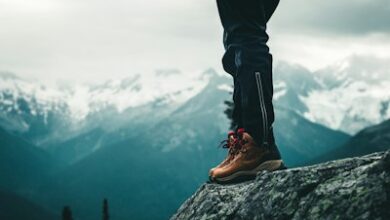What To Wear Hiking? Guide to Choose Proper Hiking Gear⏬

Setting out into the great outdoors offers an invigorating escape, but whether you’re a seasoned hiker or embarking on your first trail adventure, knowing what to wear can significantly impact your experience. Hiking apparel isn’t just about style; it’s a strategic choice for comfort, safety, and enjoyment. In this comprehensive guide, we’ll delve into the essentials of hiking attire to ensure you step onto the trail with confidence. We’ll begin by understanding why choosing the right clothing is crucial and then take a layered approach—starting with selecting the ideal base layer for comfort and support, followed by the all-important outer shell for weather protection. Along the hike, we’ll explore the benefits of moisture-wicking fabrics, step into the world of supportive and traction-enhancing footwear, and round out our packing list with accessories that bring safety and convenience to your trail experience. Lace up your boots, and let’s journey through the sartorial side of hitting the hiking paths.Explore essential hiking attire tips, from choosing base layers for comfort to picking the perfect footwear and outerwear for trail safety and support.
Understanding The Importance Of Proper Hiking Attire
Knowing What To Wear Hiking is the cornerstone of any successful outdoor adventure, as it can dictate not only your comfort but also your safety and performance on the trail. Proper hiking attire is designed with functionality in mind, equipped to handle the unpredictable elements of nature while enabling hikers to move freely and efficiently through varying terrain. Understanding the essence of each clothing layer and its purpose is critical for anyone venturing into the wilderness.
When assembling your hiking outfit, the first thing to consider is the base layer, which serves as your second skin. This layer is pivotal for maintaining a consistent body temperature by wicking sweat away from your skin, keeping you dry and reducing the risk of hypothermia in colder climates. Selecting the Right Base Layer For Comfort And Support is crucial, as the right material—such as merino wool or synthetic fibers—will provide maximal moisture management and temperature regulation.
As we delve into the outer layers, we come across the need for the Selecting The Ideal Outer Shell For Weather Protection. This layer shields you from the wind, rain, or snow without compromising breathability. An outer shell should be selected based on the climate and conditions you anticipate: waterproof and windproof materials for wet conditions, or a lightweight and breathable shell for milder environments. This strategic selection helps ensure that hikers remain protected regardless of what Mother Nature throws their way.
One cannot overstate Exploring The Benefits Of Moisture-Wicking Fabrics; these innovative materials play an instrumental role in any hiking apparel. Clothing crafted from these fabrics quickly transfers moisture from the skin to the fabric’s exterior where it can evaporate more easily, thus maintaining an optimal level of comfort and reducing the risk of chafing or rashes caused by prolonged dampness.
Finally, Finding The Perfect Footwear For Support And Traction is imperative. The choice of hiking boots or shoes can impact your balance, stability, and protect your feet from rough terrain with adequate cushioning and support. They should also provide excellent traction to handle various types of surfaces you may encounter, preventing slips and falls.
Equally important is how you Accessorizing For Safety And Convenience On The Trail. This includes items such as a hat for sun protection, gloves for warmth, and a waterproof backpack to carry essentials. Strategic accessorizing can further enhance your hiking experience, ensuring you’re well-equipped for a day or extended journey into nature. Below is a list of essential accessories that every hiker should consider:
- Navigation tools (map and compass)
- Sun protection (sunglasses and sunscreen)
- Insulation (extra clothing)
- Illumination (headlamp/flashlight)
- First-aid supplies
| Layer | Function | Material Example |
|---|---|---|
| Base Layer | Moisture management and temperature regulation | Merino wool, synthetic fibers |
| Mid Layer | Insulation | Fleece, down, synthetic insulation |
| Outer Shell | Protection against elements | Gore-Tex®, waterproof breathable fabrics |
In summation, when pondering What To Wear Hiking, the paramountcy of choosing attire from your base layer to your accessories cannot be understated. Each component of your outfit serves a distinct purpose, working in harmony to preserve your comfort, mobility, and safety—permitting you to focus on the splendor of your surroundings and the joy of the journey ahead.
Choosing The Right Base Layer For Comfort And Support
When embarking on a hiking adventure, the foundation of your attire can significantly impact your overall comfort, and determining precisely what to wear hiking can pose a challenge for outdoor enthusiasts. A crucial element of your hiking wardrobe is the base layer, which is responsible for managing moisture and maintaining body temperature during strenuous physical activity.
While selecting the right base layer, one must look for fabrics that offer superior moisture-wicking capabilities. The ability to wick sweat away from the skin to the outer surface for quick evaporation is paramount. This feature helps in keeping the skin dry and avoids the discomfort that arises from damp clothing against your skin, which can lead to chills or skin irritations on longer hikes.
Moreover, the comfort and support provided by a well-fitted base layer cannot be overstated. An ideal base layer should fit snugly without restricting movement, allowing for a full range of motion as you climb, reach, and traverse varied terrain. It’s essential to avoid any fabrics that may cause chafing; a seamless design or flat-seam construction can be vital for long-term comfort on the trails.
When it comes to materials, synthetic fabrics such as polyester and nylon or natural fibers like merino wool are popular choices for base layers. Each material has its benefits: synthetics are generally more durable and dry quickly, while merino wool is renowned for its temperature-regulating properties and natural odor-resistance.
| Material | Benefits | Considerations |
|---|---|---|
| Polyester | Quick-drying, durable | May retain odors |
| Nylon | Excellent durability, stretch | Less breathable than other fabrics |
| Merino Wool | Temperature regulation, natural odor-resistance | Higher cost, requires more care |
Finally, it’s helpful to remember that the base layer is just the first piece of a successful layering strategy when planning what to wear hiking. The right base layer provides not just comfort and support but also a foundation for additional layers that can be added or removed as weather conditions change throughout your hike.
Selecting The Ideal Outer Shell For Weather Protection
When venturing into the great outdoors, the selection of an appropriate outer shell is crucial for full weather protection, ensuring that hikers remain dry and comfortable throughout their journey. An outer shell is the guardian against capricious weather conditions—it’s the armor that stands between you and the elements. Thus, when considering What To Wear Hiking, one’s focus must land firmly upon finding a jacket that not only repels water but also offers breathability, without sacrificing durability.
An ideal hiking outer shell should embody a delicate balance of features: it needs to be lightweight enough to ensure that hikers aren’t weighed down by their own defensive garb. But more than just any jacket will do; it should possess adjustable features such as hoods, cuffs, and hems to enable a custom fit that secures against wind and rain. When selecting your outer shell, envisage the environment you’ll be trekking through, and choose materials that stand up to those specific challenges.
Understanding that the weather can shift with little warning is fundamental when considering What To Wear Hiking. The outer shell you select should easily transition from a protective barrier against a sudden downpour to a breathable shield against gusts of wind. Many hikers opt for layers that can be adapted on the fly: utilizing zippered vents for increased airflow or cinching waistbands to ward off chilly drafts. Such versatility in a garment is invaluable on the trail, where conditions switch as swiftly as the paths beneath your boots twist and turn.
Seasoned adventurers know that the fabric of the outer shell also matters immensely. Technologies such as Gore-Tex or eVent have revolutionized outdoor apparel, offering waterproof yet breathable fabrics that help maintain a comfortable internal microclimate. These moisture-wicking materials ensure sweat is transported away from the body, diminishing the risk of unintended chills due to wet underlayers—a crucial factor to consider in the quest for the perfect What To Wear Hiking ensemble.
Beyond just fabric and features, consider also a shell’s compatibility with the rest of your gear. Pockets must be accessible, even when wearing a backpack, and zippers should be operable with gloves on, for those cooler climates. Reviewing the
- fit
- functionality
- and weight
of your outer shell will prove foundational to a fulfilling hiking experience. In summary, while the protective outer shell might just seem like another piece of gear, it is indeed the bulwark between you and the majesty of nature’s unpredictability.
| Feature | Description | Benefit |
|---|---|---|
| Waterproof | Coated fabrics or membranes that block water from penetrating. | Keeps you dry in the rain or snow. |
| Breathable | Materials that allow perspiration to escape. | Reduces overheating and maintains comfort. |
| Adjustable Features | Hoods, cuffs, and hems that can be tightened or loosened. | Customizes fit and seals out the elements. |
| Lightweight construction | Less material used or lighter materials chosen. | Makes for easier movement and reduces fatigue. |
Exploring The Benefits Of Moisture-Wicking Fabrics
When embarking on a hiking adventure, selecting apparel that supports your endeavor maximizes both comfort and performance. Perhaps one of the most significant advancements in sports and outdoor apparel has been the development of moisture-wicking fabrics. These innovative materials are designed with the specific intention of drawing sweat away from the body, which in turn helps to maintain a consistent body temperature and reduce the discomfort associated with damp clothing.
Investing in hiking gear that incorporates moisture-wicking fabrics can drastically improve your outdoor experience. As you exert yourself on the trails, your body’s natural response is to perspire to cool down. Traditional fabrics tend to absorb this moisture, becoming heavy and potentially leading to overheating or chills as conditions change. However, moisture-wicking fabrics quickly transfer this perspiration to the fabric’s outer surface, where it can evaporate more readily, keeping you dry and comfortable throughout your hike.
The implementation of these technical fabrics is not limited to just one type of hiking garment. You’ll find that a range of items, from base layers to hats, now utilize this technology. When considering What To Wear Hiking?, it’s beneficial to look for a base layer that fits snugly against the skin to fully reap the moisture-wicking benefits. Below is a table showcasing different types of hiking apparel that may feature moisture-wicking properties:
| Garment | Function | Material |
|---|---|---|
| Base Layer | Direct moisture management | Synthetic (Polyester, Nylon) or Merino Wool |
| T-Shirt | Everyday versatile use | Synthetic (Polyester) or Blends |
| Hiking Pants/Shorts | Comfort and flexibility | Synthetic (Nylon, Spandex) |
| Hiking Socks | Foot comfort and sweat management | Merino Wool or Synthetic Blends |
In addition to keeping you dry, moisture-wicking fabrics also typically offer other benefits such as odor resistance and quick drying times, which are highly valuable on multi-day treks. When mapping out What To Wear Hiking?, consider the range of activities you’ll be undertaking and the weather conditions. Moisture-wicking capabilities become especially crucial when navigating through unpredictable climates or engaging in strenuous hikes where sweat production will be higher. Always prioritize these high-performance fabrics for the most efficient moisture management on the trails.
Finding The Perfect Footwear For Support And Traction
When embarking on a hike, one of the most important decisions you can make is the selection of your footwear. Hiking boots or shoes are the foundation of your hiking attire and play a vital role in ensuring your safety, comfort, and enjoyment. But with so many options on the market, how does one navigate the plethora of choices to find the perfect footwear for support and traction?
Firstly, it is crucial to consider the terrain you will be tackling. For rugged mountainous trails, look for boots with ample ankle support and stiff midsoles, which are designed to prevent sprains and provide stability on uneven ground. On the other hand, for more casual, well-groomed trails, a lighter hiking shoe might suffice, offering more flexibility and a quicker break-in period. Therefore, when pondering What To Wear Hiking?, one must reflect upon the nature of the trails they will traverse.
Another aspect to consider is the sole of the footwear. A deep-lugged sole made of a durable rubber compound will afford excellent traction, which is indispensable when tackling slippery or steep surfaces. Waterproofing is also an important feature, particularly if you expect to encounter streams or wet conditions. Many hikers prefer shoes with a waterproof membrane, such as Gore-Tex, which works to repel water while still allowing the feet to breathe, thus embracing the benefits of moisture-wicking fabrics within the shoe’s construction.
Lastly, before making a purchase, one must always try on several options and walk around to gauge comfort and fit. The fit should be snug but not too tight, allowing for natural swelling that occurs during a trek. It is often recommended to try on hiking footwear with the socks you intend to wear on your hikes to ensure the most accurate fitting experience. With the ideal balance of support, traction, and comfort, your footwear choice will undoubtedly elevate your hiking experience, embodying the essence of choosing the right base layer for comfort and support.
| Feature | Description | Benefits |
|---|---|---|
| Ankle Support | High tops to support the ankle and prevent twisting | Stability on uneven terrain |
| Sole Traction | Deep-lugged soles for grip | Secure footing on slippery surfaces |
| Waterproofing | Materials like Gore-Tex to repel water | Dryness and comfort in wet conditions |
| Fit and Comfort | Room for swelling, proper cushioning | Enhanced endurance and reduced blistering |
- Understanding The Importance Of Proper Hiking Attire is paramount in choosing footwear that will see you through various landscapes with ease and protection.
- Selecting the ideal outer shell for weather protection doesn’t just stop at clothing; your shoes act as the outer shell for your feet and must provide similar defense against the elements.
- Accessorizing For Safety And Convenience On The Trail includes the use of gaiters or crampons if required, which should be compatible with your chosen hiking footwear.
Accessorizing For Safety And Convenience On The Trail
When planning an outdoor trek, What To Wear Hiking? is often the first question on an adventurer’s mind. However, beyond selecting the right clothing, the accessories you choose can greatly enhance both safety and convenience.
Sturdy footwear is a non-negotiable element, but what about the items that ensure our day on the trail is as smooth as possible? This is where the right accessories come into play. From ensuring that you’re never without a navigational aid to providing emergency support, accessories are vital. Here we will discuss how to carefully select these items for a comfortable and secure hiking experience.
- Navigation tools like a map and compass, or a GPS device, ensure you remain on the right path.
- Hiking poles offer stability and support, especially on uneven terrains.
- A multi-tool can be invaluable for quick fixes or unforeseen tasks that require a sharp edge or a pair of scissors.
- Hydration systems such as water bladders or filtration devices are crucial for maintaining access to clean drinking water.
Let’s take a closer look at these accessories for a moment, breaking them down in terms of their role and necessity for a hiker.
| Accessory | Function | Benefit |
|---|---|---|
| Navigation Tools | Orientation and Route Planning | Prevents getting lost, saves time and energy |
| Hiking Poles | Stability and Balance | Reduces strain on knees, assists in difficult terrain |
| Multi-Tool | Versatile Utility | Adapts to various situations, can be lifesaving |
| Hydration Systems | Water Storage and Purification | Ensures continuous hydration, vital for long routes |
Remember, each accessory you pack should justify its weight with its utility, especially when every ounce counts on a long hike. Properly Accessorizing For Safety And Convenience On The Trail is as important as picking out the right hiking boots or choosing apparel made from moisture-wicking fabrics. Smart choices in your hiking gear can dramatically increase your comfort and safety, allowing you to focus on the beauty and thrill of the journey.
Frequently Asked Questions
Why is choosing the right clothing for hiking important?
Choosing the right clothing for hiking is important because it ensures comfort, protects against weather elements, and can prevent injuries. Proper attire can regulate your body temperature, manage sweat, and protect your skin from harsh UV rays, insects, and abrasions from plants or rocks.
What should I consider when picking out hiking boots or shoes?
When picking out hiking boots or shoes, consider the terrain you will be hiking on, the support and cushioning you require, the boot or shoe weight, waterproof capabilities, and how well they fit your feet to prevent blisters and discomfort.
Is it necessary to wear a hat while hiking, and if so, what kind?
Yes, wearing a hat while hiking is recommended to protect your face and neck from the sun’s UV rays. A wide-brimmed hat is ideal for sun protection, while a warm beanie is suitable for cold weather. Depending on conditions, a hat with ventilation can also help regulate body temperature.
Are there specific materials I should look for in hiking clothes?
Yes, look for materials that are moisture-wicking, quick-drying, and breathable such as polyester, nylon, or merino wool. Avoid cotton as it retains moisture and can lead to chafing and hypothermia in cooler climates.
What type of backpack is recommended for a day hike?
For a day hike, a lightweight backpack with a capacity of 10 to 30 liters is recommended. Look for backpacks with comfortable straps, adequate pockets and compartments, and a hydration reservoir or space for water bottles.
How do layering systems work for hiking apparel?
Layering systems for hiking involve wearing multiple layers that you can add or remove based on weather changes and your activity level. The typical layers include a base layer for moisture management, an insulating middle layer for warmth, and an outer layer for wind and water protection.
Should I invest in waterproof clothing for hiking?
If you often hike in areas with unpredictable weather or wet conditions, investing in waterproof or at least water-resistant clothing is wise. Waterproof jackets and pants can prevent you from getting soaked and help maintain body temperature during wet hikes.











